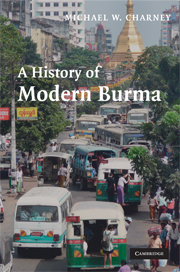Book contents
- Frontmatter
- Contents
- List of figures
- List of maps
- Chronology
- Abbreviations
- Introduction
- Chapter 1 Burma under colonial rule
- Chapter 2 The colonial center
- chapter 3 Self-government without independence, 1937–1947
- Chapter 4 The democratic experiment, 1948–1958
- Chapter 5 Dress rehearsals, 1958–1962
- Chapter 6 The Revolutionary Council
- Chapter 7 The BSPP years
- Chapter 8 Toward democracy, 1988–1990
- Chapter 9 Perpetual delay, 1990 to the present
- Conclusion
- Notes
- Readings
- Index
chapter 3 - Self-government without independence, 1937–1947
Published online by Cambridge University Press: 05 February 2015
- Frontmatter
- Contents
- List of figures
- List of maps
- Chronology
- Abbreviations
- Introduction
- Chapter 1 Burma under colonial rule
- Chapter 2 The colonial center
- chapter 3 Self-government without independence, 1937–1947
- Chapter 4 The democratic experiment, 1948–1958
- Chapter 5 Dress rehearsals, 1958–1962
- Chapter 6 The Revolutionary Council
- Chapter 7 The BSPP years
- Chapter 8 Toward democracy, 1988–1990
- Chapter 9 Perpetual delay, 1990 to the present
- Conclusion
- Notes
- Readings
- Index
Summary
Historians usually view the late 1930s and the Japanese occupation period (1942–1945) separately. Certainly, in the context of the greater Asia-Pacific region, Burma can be viewed as an example of a colony that was shaken and redirected by Japanese wartime occupation. From the perspective of Burmese efforts to achieve independence from Britain, however, late 1930s parliamentarianism and “independence” under the Japanese between 1942 and 1945 were part of a single period in which unique circumstances allowed the Burmese to gain fluctuating degrees of independence and experiment with different models of government and political control. Thus examining the 1937–1947 years as a single period makes good sense, at least in terms of Burma’s political history.
During this period, the Burmese experienced different political arrangements under the British and the Japanese that allowed for limited self-rule, but never complete independence. The main reason was that the controlling power, whether Britain or Japan, was reluctant either to lose control of the Burmese economy and Burma’s resources or to compromise broader regional security (in Britain’s case, the security of India; in Japan’s, its strategic position in wartime Southeast Asia). At no point prior to 1947 was Burma a unified whole, the Scheduled Areas (later renamed the Frontier Areas) remaining separate from parliamentary (lowland) Burma under both the British and the Japanese.
- Type
- Chapter
- Information
- A History of Modern Burma , pp. 46 - 71Publisher: Cambridge University PressPrint publication year: 2009



